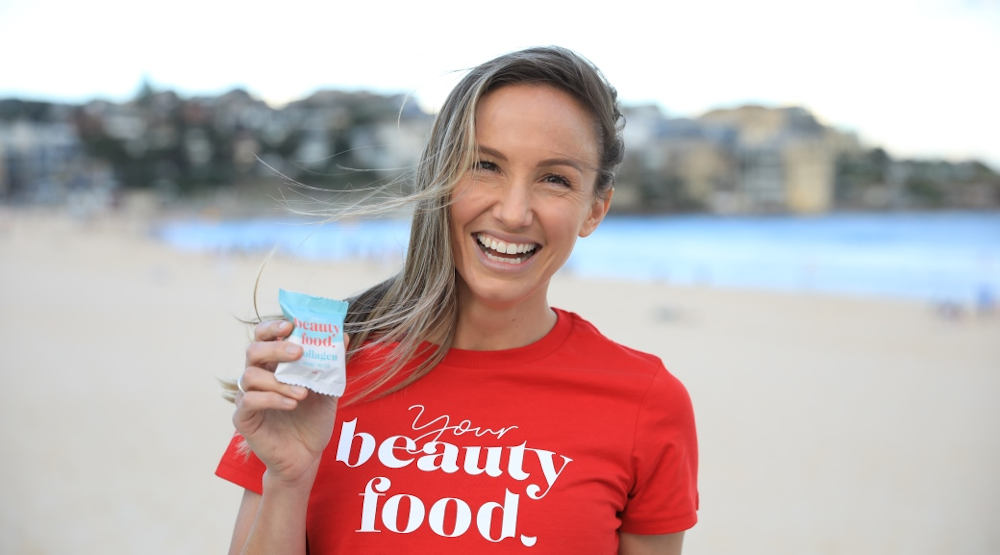By Libby Babet, Co-Founder of Beauty Food
What is collagen?
Collagen is the most abundant protein in the human body. It’s found in your hair, your skin, your nails, and is the main protein in your connective tissue, which basically connects your whole body. Once you get to 25 years old your collagen production starts to reduce, which is why young people have bouncy, full skin and as you get older your skin seems less elastic. This is the same with the collagen that helps your hair, skin and nails stay healthy, or the collagen that keeps your joints and tendons strong and supple. So, the more you can boost your collagen levels, the younger you will look and feel. While the research is still in its infancy, there are plenty of studies that show consuming collagen supplements can help you increase your body’s collagen levels. In fact, I was so impressed with the research I launched my own collagen snack product Beauty Food.
What types of collagen are there?
Drinking bone broth is one way to increase your collagen intake, but more recently we’ve seen a lot of collagen powders and collagen snack bars/bites which make consuming collagen a lot more convenient. There are twenty-eight known types of collagen but as far as supplementation goes let’s look at the four important ones.
TYPE I COLLAGEN
Best known for its anti-ageing properties including minimising wrinkles and improving the skin’s health and hydration. One study showed it reduced the prevalence of cellulite, especially in women of otherwise normal weight ranges.
Best Sources for Type I Collagen
• Marine collagen (careful here, almost all marine collagen is sourced from factory farmed fish and sometimes crustaceans which can be inflammatory for some people)
• Bovine collagen (this is what we use, it’s a safer product to use in food manufacturing, look for grass-fed)
• Protein-rich foods, like fish and beef
• Bone broth (considered to not be as easily absorbed as other collagen sources)
TYPE II COLLAGEN
Best known for treating joint pain and promoting joint health.
Best sources
• Bone broth
• Chicken collagen
• Protein-rich foods, like chicken
TYPE III COLLAGEN
Some say it aids intestinal health but the studies don’t yet agree. There is evidence it can enhance exercise performance and building muscle.
Best sources
• Bovine collagen
• Protein-rich foods, like beef and fish
• Bone broth
TYPE IV COLLAGEN
Best known for
Improving wound healing and assisting the forming of embryos.
Best sources
• Egg whites
• Other protein-rich foods
• Type IV collagen is very difficult to find in supplement form
Is there such thing as vegan collagen?
For those following a vegan diet, please note that collagen comes from animals. There are plenty of vegan “collagen” products out there that claim to “support” collagen production but they don’t actually contain collagen and the science just isn’t there to support the claimed health benefits. For those who aren’t strict vegans, I do have many plant-based friends who consume collagen for its health benefits instead of meat.
What else should you know about consuming collagen?
When you’re consuming collagen the number one rule is to avoid combining it with sugar. Sugar competes with Vitamin C which is important to absorbing collagen. That’s why my Beauty Food bites are low sugar and infused with Vitamin C.
Other supplements and nutrients have been shown to aid in collagen synthesis:
• Glycine, found in pork and chicken skin
• Proline, found in dairy, cabbage, asparagus, mushrooms
• Copper, found in sesame seeds, cocoa, cashew, lentils
• Zinc, found in shellfish, chickpeas, lentils, dairy, eggs
How much collagen should I take?
Most of the research is based on at least 5g of collagen per day, sometimes higher. That’s why we have 7.5g per serve in Beauty Food for example. Many companies have next to no collagen in their “collagen” products and try to hide this by quoting in milligrams. For example, 3000mg of collagen is not a large enough serve based on the research. Look for over 5g (5000mg).
esprit has FIVE boxes of Beauty Food to give away. To be in the running to win, simply visit our COMPETITION page.
Resources
3. The Role of Type III Collagen in the Development of Familial Abdominal Aortic Aneurysms
4. Collagen IV in Normal Skin and in Pathological Processes
5. Serum Laminin and Collagen IV in Inflammatory Bowel Disease
6. STRETCH MARKS: WHY THEY APPEAR AND HOW TO GET RID OF THEM

